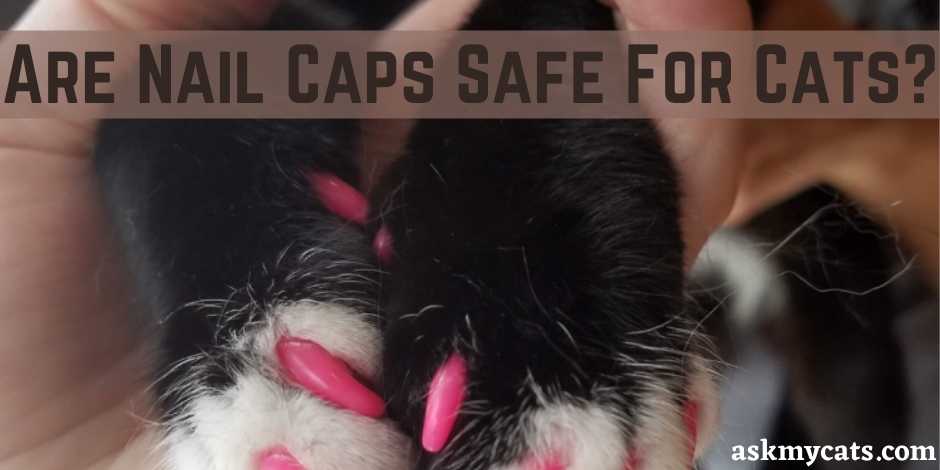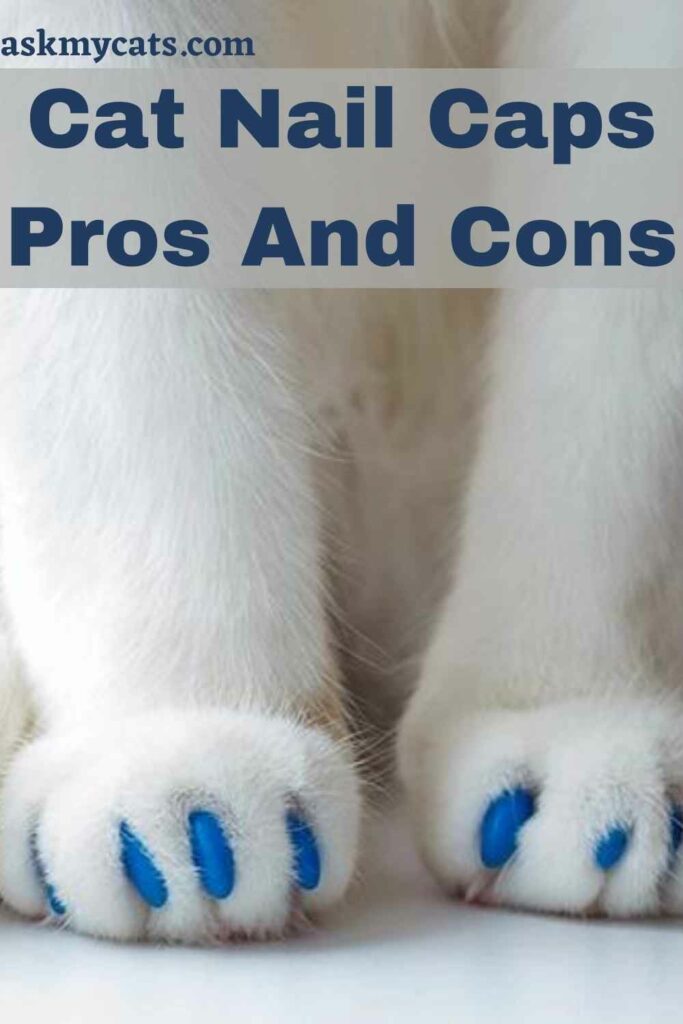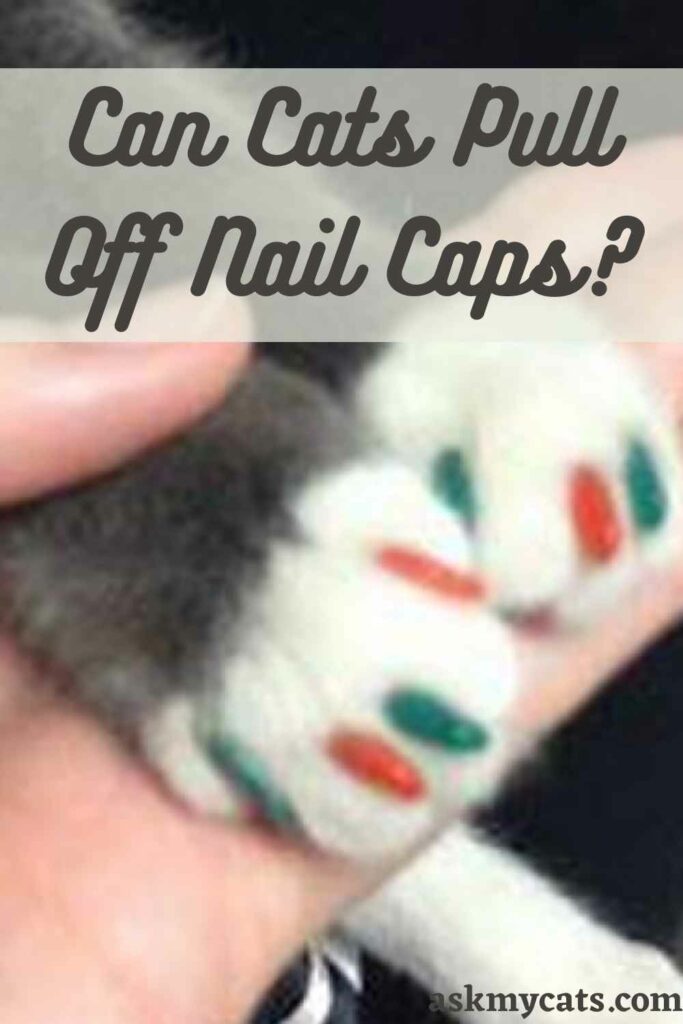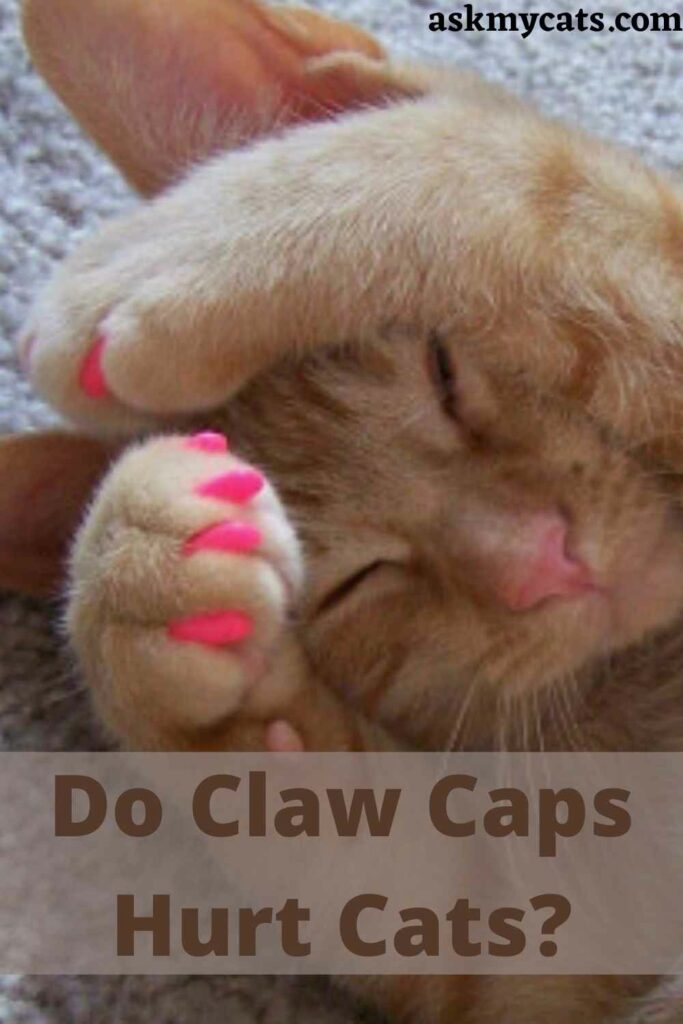Cat nail caps are becoming more and more popular these days. They can safeguard our pets as well as anything around the house that our feline companions enjoy scratching, such as furniture. But are cat caps safe for cats?
Yes, nail caps are totally safe for cats. They should also not cause any discomfort or damage to the claw beds.
Keep reading the article to know all the pros and cons of nail caps.


Give Your Cat the Perfect Day
Get the Free Ebook!
What Are Cat Nail Caps?
Cat nail caps are small plastic caps that are glued to a cat’s claws.
Small plastic caps that are bonded to a cat’s claws are known as cat nail caps. They’re rounded, velvety, and firm. They are non-toxic and straightforward to use since you can apply them to your cat without the need for help.
These caps are typically worn for four to six weeks before falling off as a cat’s nails naturally develop. These caps are suitable for kittens aged three months and up, as they are available in kitten sizes.
Why Should I Use Cat Claw?
You can use a cat claw in order to protect your furniture and body from your cat’s claws.
Cat claws are razor-sharp so that they can defend themselves against predators and such. Cats also have to scratch things, which isn’t a problem in the wild because they can scrape tree trunks.
As a result, the scratching post, a tall pole that encourages cats to approach it like a tree in the wild, is wise. Unfortunately for humans, various items in your home, such as furniture, door frames, and your leg, stimulate cats to scratch.
Cat Nail Caps Pros And Cons
Cat nail caps have several pros and cons. Some of them are: –

Pros
Nail Caps Protect Your Furniture and Drapes: Nail caps are one of the most efficient methods for preventing your cat from clawing fabric, leather, carpeting, drapes, or anything else they can get their claws on. Your cat will still try to claw, but the caps will deter him from doing so, keeping you both pleased.
Nail Caps Aid in the Prevention of Accidental Scratches and Injuries: Nail caps are also an option for cats who have poor claw control, are aggressive, or must be around strangers or small children. The soft tips protect you from accidental or intentional scratches, keeping you safe.
Nail caps are usually inexpensive: Nail caps are usually inexpensive, particularly if you learn how to apply them yourself. Even if you buy several sets of nail caps, you’ll still save money compared to professional nail trimming or other options.
Nail Caps Can Be Used As A Training Aid For Scratching Posts: If you’re still teaching your cat to use scratching posts, nail caps can be a good option because they don’t cause any permanent changes to your cat’s paws or claws.
Normal Claw Growth Is Unaffected by Nail Caps: Nail caps, contrary to popular belief, still allow normal claw growth. That is why the nail caps fall off every 4-6 weeks; the outer layer of nails sheds with the cap.
Nail Caps Can Be Used In The Short Or Long Term: Nail caps can be worn for as long as your cat needs them, in 4–6 week intervals. There’s no need to keep using them if your cat doesn’t need them, and you can always start using them again if necessary.
Properly Applied Nail Caps Have No Increased Risk Of Infection: Correctly applied nail caps, unlike declawing, do not raise the risk of infection in your cat’s paws. However, because a poor application might raise the risk of infection, it’s critical to ensure sure the nail caps aren’t irritating the nail bed or causing abrasions.
Cons
Nail Caps Need Regular Replacement: Nail caps are simply a temporary remedy that will fall off as your cat’s claws grow. You’ll need to replace them every 4-6 weeks, and individual caps may need to be replaced even more frequently.
Not All Cats Tolerate Nail Caps: Nail caps may seem strange to your cat at first, but most cats acclimatize. Unfortunately, not all cats will acclimate to nail caps, and for others, they can be a major source of worry.
Nail Caps Can Change How Your Cat Walks: When your cat initially gets nail caps, they may not be able to move normally. Others don’t appear to grow acclimated to the covers and will ultimately learn to walk properly again.
Cats Cannot Be Allowed Outside While Wearing Nail Caps: Because claws are your cat’s primary defense and hunting weapon, if they are allowed outside, nail caps may make them too vulnerable. Only if your cat goes for leashed walks under your supervision or if they have a covered and secure cattio is there an exception.
Some Cats Fight Nail Cap Application: Many cats dislike having their paws tampered with, and others refuse to have their nails capped. This can result in scratches, a problem with the glue, and other issues.
Some Cats Chew And Swallow Nail Caps: Some cats, particularly those who have problems with nail caps in other ways, will gnaw their nails to remove the caps. If they succeed, they may eat the nail cap, necessitating a trip to the veterinarian to ensure the cap does not become an obstruction.
Nail Caps Can Interfere With Your Cats Ability to Climb: Cats who enjoy running, jumping, and climbing may find it difficult to continue doing so once you’ve fitted them with nail caps. Claws are used for grip in climbing, and they can also be used for leverage and stability in jumping. Your cat’s mobility may be limited if its claws are capped.
It’s critical to monitor your cat’s behavior, temperament, and other markers of how well they are adjusting to wearing nail caps. While nail caps may make managing your cat easier, they may not be worth it if your cat is extremely bothered by them or if they interfere with your cat’s preferred pastimes.
Cat nail caps aren’t for everyone, but if they suit your cat, they can be an excellent tool.
Also, find out how to remove cat nail caps
Can Cats Pull Off Nail Caps?
Yes, cats can pull off nail caps.

The first few times you apply nail caps, they may attract a cat’s attention, causing them to nip or pick at them.
This is totally normal, and after a few weeks or a few applications, almost all cats will leave them alone.
Many cats are averse to having their paws tampered with, and others refuse to trim their nails.
This can lead to scratches, adhesive problems, and other problems.
Some cats will nibble their nails to remove the caps, especially if they have other problems with nail caps.
If they succeed, the nail cap may be eaten, necessitating a trip to the veterinarian to verify that the cap does not create a blockage.
Positive reinforcement with treats, toys, and snuggles can assist distract from picking at the nail tops and soothe the cat during nail cutting and application, as it can with many other behaviors.
You would like to read about what to do if cat nail bleeding after cutting
How Long Do Nail Caps For Cats Last?
On average, the nail caps last for 4-6 weeks.
Nail coverings do not prevent cat nails from growing naturally. As a result, when wearing the nail caps, the nails continue to grow at a regular rate and have the potential to grow longer than is comfortable.
Even if your cat ignores the nail caps the first time they are applied, they should not be left on the nails for more than 4-6 weeks.
Before applying a new set of nail caps, the existing caps should be removed with nail trimmers and the nails trimmed and cleansed. This helps to keep the nails healthy and long while also protecting them from scratching.
You might also like to read about why do cats like nail files
Do Claw Caps Hurt Cats?
No, claw caps do not hurt caps if applied the right way.

Many people are perplexed by this since it appears odd and strange to see a cat encasing its nails with brightly colored plastic bits.
Cat nail caps, on the other hand, do not harm cats. As long as the nail caps are properly put, they can expand and retract their claws regularly.
While wearing the nail caps, cats should be able to walk, run, climb, and play normally.
This is due to the fact that a cat’s front nails retract when walking in order to maintain them sharp.
As a result, covering the nails with small plastic caps should have no effect on their movement.
On the other hand, back claws do not retract, which is why kitty’s back nails are naturally shorter and require less clipping.
Having said that, keep in mind that each cat is an individual with its own habits and preferences. While most cats are unconcerned about nail caps, others may struggle to acclimate or attempt to eat them off.
As a result, cat nail caps are usually employed as a last resort after all other scratch training methods have failed.
What Training Methods You Should Try Before Purchasing Cat Claw Caps?
Before purchasing cat claw, you can try these training methods: –
- Give your cats dedicated cat furniture, such as scratching posts, cat trees, and cat condos, that they scratch to their heart’s content.
- Discourage your cat from scratching your furniture by covering it in tin foil, using double-sided tape or a plastic protector.
Your cat will eventually quit scratching your furniture, and you will no longer need to cover it.
You can also cut your cat’s nails to keep them dull, so they don’t scratch your furniture and don’t get in the way of anything else your cat wants to do with them, such as stretching and leaving odors around the house.
Should You Apply Nail Caps To Your Cat’s Hind Paws?
Yes, you can apply nail caps to your cat’s hind paws, but it is not necessary.
The front paws of a cat do the majority of the harm. Furthermore, most cats keep their back claws short by gnawing them down on a regular basis. The use of nail caps on a cat’s hind claws is advantageous in a few situations:
- To reduce the amount of damage caused by cats jumping on and off furniture.
- To prevent cats from inflicting self-inflicted wounds by scratching excessively. Kittens with sensitive skin will benefit from covering both their front and hind claws.
Frequently Asked Questions
What are the alternatives to nail caps?
Sticky paws or couch defenders are excellent solutions for preventing cat nails from damaging your couch. Make sure your cat has scratching posts, and catnip is an excellent method to pique his attention. Experts advocate training and behavior modification coupled with a management tools. Nail caps are no longer necessary after most cats have been taught to scratch on appropriate surfaces and not to use their claws on people.
Will vets put nail caps on cats?
It is dependent on the veterinarian. Some veterinarians will cap your cat’s claws, especially if they also provide grooming services or if you’ve been working with them to address undesirable claw behaviors. Even vets that are willing to put nail caps on your cat will probably want to teach you how to do it yourself because it’s a simple process that needs to be done frequently enough that your vet won’t want to do it every time.
What are the best cat nail caps?
Some of the best cat nail caps are – 1. Soft Paws’ Claw Covers For Kitties 2. VICTHY Soft Pet Cat Nail Caps 3. Purrdy Paws Soft Nail Caps For Cat Claws 4. JOYJULY Cat Soft Claws Caps and 5. Ninery Ave Cat Nail Caps.
Final Words
Hopefully, you’ve gained a better understanding of whether or not nail caps are a good fit for you and your cat. They’re the ideal option for certain families and can help you re-establish harmony in your home.
If you have any unanswered questions, ask us in the comments section.
